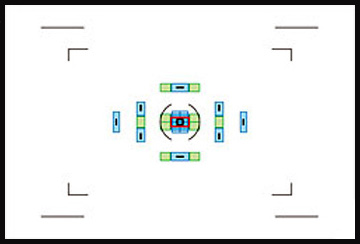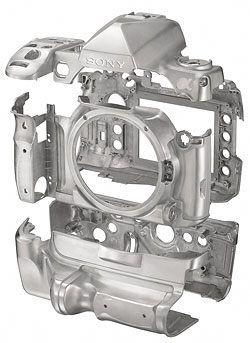Sony A900 Full-Frame: Hands-On Preview
by Wesley Fink on September 12, 2008 12:00 AM EST- Posted in
- Digital Camera
A900 Praise
When a camera and company truly break new ground, as the A900 does, there is plenty to like. The A900 also exhibits quite a few market firsts:

The blue bars are the 9 AF sensors and the green bars are the 10 hidden AF assist points.
The outer lines are used to compose 16:9 HD format, and the etched corners are APS-C mode.
The outer lines are used to compose 16:9 HD format, and the etched corners are APS-C mode.
- The Most Amazing Viewfinder - If the reason for an SLR is the through-the-lens view, and it certainly is in the opinion of most, then the A900 wins in spades with the brightest, sharpest viewfinder seen in any SLR in a long time - perhaps ever. Sony and the Minolta engineering staff they bought have lavished attention on the prism and 100% view and it clearly shows. The only complaint is that eye-relief, while excellent, could be even better. It will be difficult for some eyeglass wearers to see the whole viewfinder and displays without moving their eye a bit. The view is so beautiful and clear you will definitely want to see it all.
- A 24.6MP CMOS Sensor - Some will complain that noise is not as low as the Nikon D3 at high ISOs, and the answer is so what? The A900 is the highest resolution full-frame you can buy and twice the resolution of the D3. If you think that doesn't matter ask a working professional who is trying to supply images to his ad agency. Image buyers are demanding larger and larger files from photographers and the Sony delivers.
- Body-Integrated Image Stabilization - Calling it SteadyShot Inside instead of Super SteadyShot is just a marketing decision. The technology is still "Super SteadyShot" and Sony had to beef up the drive motors by 50% just to keep up with the added motion of a full-frame. Industry observers marveled when Minolta made the APS-C sensor Image Stabilized, because it was so much harder than stabilizing the tiny P&S sensors. We should all stand in awe that Sony accomplished body IS in a full-frame sensor.
- Image Stabilization with Any Lens - With body IS any lens you can mount can be an IS lens. This is particularly welcomed in very large aperture lenses, which are often prohibitively expensive for optical IS since such huge elements have to be compensated. Sony has taken advantage of this with a growing collection of fast, but very expensive, Zeiss lenses.

- Rugged Magnesium Alloy Body with Complete Weather Sealing - Sony passed around the alloy shell of the A900 at the A900 introduction. It is amazing how light the structure actually is considering the incredible strength of the assembled shell. We also saw full seals and gaskets for all buttons and openings and the rubber gaskets for ports seal effectively but are still easy to remove and reseal.
- Very Decent High ISO Noise - Compared to its real competition, which is the Canon 1Ds Mark III, the Sony sensor is amazingly low noise. According to pro photographers we talked with who have been shooting the A900 for several weeks the A900 is cleaner at ISO 800 and 1600 than the Mark III and just as clean at ISO 400. If this proves to be true in test comparisons this should certainly be considered a Sony success. The Canon 5D replacement may write a new chapter in this comparison, but only if it destroys the 1Ds Mark III performance. The A900 is not a D3 or D700 as it only goes to ISO 6400 and shooting at 3200 and 6400 is a when needed option - not something you want to do routinely. However, the A900 is also twice the resolution of the D3 and D700.
- 126 MB per Second - the Dual BIONZ processors in the A900 move 126MB/sec at the 5 fps shooting speed - faster even than the Canon 1Ds III. That's pretty good performance for a camera that will sell for $3k instead of the $8K for the Canon.

- Flash that Makes L Brackets Obsolete - Fortunes have been made with L brackets for pro cameras that enable shooting flash vertical with the flash also rotated 90 degrees. When you see the new Sony HVL-F58AM flash, you'll wonder why Sony - or you, or anyone else - didn't think of it sooner. The flash head turns smoothly in a 90 degree arc as one of its movements - aligning the flash perfectly for portrait mode. Goodbye L bracket.
- Sony PhotoHD output to Bravia TV - The support for direct tethered output via HDMI to Sony's Photo HD on a Sony Bravia TV is no passing feature. The performance and results seen at the Toronto hands-on were stunning. Output from the A900 model shoot and the studio shoot with fishing lures and flies was direct to huge Sony HD Bravia displays.
- Complete Familiarity - Users of the Sony A700 will have no learning curve at all, which is always a good thing. The layout of the A700 and A900 and grips are exactly the same, making for instant familiarity.
- True RAW Files - The Sony A700 has been criticized by some sites for not providing true RAW images, as even the Sony RAW had some noise-reduction applied with questionable success. The A900 finally has the RAW option of "No Noise Reduction". Sony will also provide this option to A700 owners in the upcoming firmware version 4.










53 Comments
View All Comments
chiew - Saturday, September 13, 2008 - link
what conditions did the a700 survive in that the 1Ds didn't?hanugro - Friday, September 12, 2008 - link
Hm ,I do remember last year that I heard about shooting video and choosing 1 fram as digital still from SOny CEO himself. I don't know whether it is his idea or he heard from someone else. But Sony has stated that it won't put feature that is not ready. I am sure it has cross Sony's mind. Also they are one that among the first develop sensor that can take 120fps but at lower resolution. You have to understand that this 24MP create about 15MB per frame. If your video is 24fps then does the CF available now is big enough? Also don't tell me that SOny should allow lower HDTV 1920x1080 pixel video and hope that you can extract one frame of it and sell it to newspaper. They will laugh at it, newspaper / magazine needs at least 6-12MP pictures before they consider to publish it. Also if you want video then buy videocam instead. I imagine using liveview (or using the sensor for video) will shorten the live of the sensor itself. Whay would I want to do that?aeternitas - Friday, September 12, 2008 - link
I think people willing to pay 3k for a camera;#1 Dont care about 100$ battery. (wtf?)
#2 Could get something better for a bit more if they want new.
#3 Something better for less if they buy used.
#4 Nikon and Cannon will come out with something better for less in a matter of a few months.
"Full frame" is great, but all it does is get rid of crop factoron 35mm cameras. What happeneds when CCDs get bigger? They will need to, becuse no matter what technology the camera has in it, SnR is going to be better at lower MP resolutions on the same size CCD. 24MP sounds fantastic, but noice reduction does not always equate to added detail. The only real way to get more detail, is to actualy replace noise with information and the real only wat to do that is to make the CCD bigger or make the pixelsites bigger.
gipper51 - Friday, September 12, 2008 - link
Nice preview of a very interesting camera. I did notice several times you mentioned the Sony as being twice the resolution as the D3/5D which is not accurate. It has twice the pixels but you need 4x the pixels to truly double a sensors resolving power.This camera should shake up the industry on the high end. I can't see Canikon shooters ditching their current investments and going with Sony because of this cam, but at the very least the era of high resolution FF cameras costing as much as a new compact car is over. Bravo Sony.
chiew - Friday, September 12, 2008 - link
Just a note: Canon's 1Ds mkIII has a larger viewfinder than the A900 in specs...Canon 1Ds mkIII: .76x 100% FF vf
Sony A900: .74x 100% FF vf
Yea the Canon costs more than 2x as much. However, if history has its say, Canon will trickle down the viewfinder like it did from the Canon 1Ds mkII to the 5D (0.70x in the 1Ds mkII and 0.71x in the 5D). Whatever Canon has up its sleeve, its likely a full frame, and hopefully Canon users will get a nice large viewfinder in whatever the followup to the 5D is.
KorruptioN - Friday, September 12, 2008 - link
As for the bump in fps rate with cropped lenses like Nikon does, apparently this is due to a lens design decision by Minolta. The aperture arm must travel a much more significant distance compared to the aperture arms in Nikon's lenses. This physical requirement alone is likely what is limiting all of Sony's DSLRs to 5fps maximum.Wesley Fink - Friday, September 12, 2008 - link
I shot several images with DT lenses and the A900 crop factor worked perfectly. You can also manually force DT, even on a full-frame lens. With that capability, and an 11 megapixel image size in crop mode, a faster shooting speed would have been an incredible feature. The Nikon 5 megapixel crop-mode image is OK for newspaper but too small for some things. An 11 megapixel crop is a lot more interesting.strikeback03 - Friday, September 12, 2008 - link
The point of an L bracket is to get the flash above the lens regardless of camera orientation. This new flash still has the flash offset to the side, so you still need a bracket if you want to move your flash over top of your lens.Wesley Fink - Friday, September 12, 2008 - link
There are some cases where an in-line flash is more desirable, but for most situations where photographers use a flash the Sony 90 degree turn will accomplish just what the photographer is looking for when he attaches an L bracket.haplo602 - Friday, September 12, 2008 - link
I bought a Nikon F75 as my first SLR after some long search and decision making. Then a few days after it's arrival I learned about the Minolta Dynx 7 and regreted my decision. A few months later I had the opportunity to actualy shoot with a Minolta 7D and I was even more unhappy.Now with this new Sony, I am close to tears. The Nikons I have are solid cameras, I do not complain there, however any Nikon camera close to this Alpha sensor will cost a fortune which I cannot afford. The A900 seems like a quality and "cheap" camera.
(I have to add I never owned a DSLR :-))